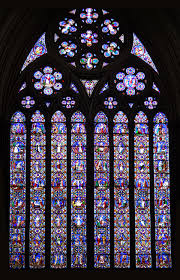Stained glass
Stained glass is a type of glazing material that is coloured (stained), either by the addition of metallic salts during the manufacturing process, or by having colour applied to its surface and then being fired in a kiln to fuse the colour to the glass.
Stained glass can be used for a wide range of purposes, but it is most commonly found in flat panels in windows. Stained glass windows typically comprise small pieces of coloured glass held in place by a latticed web of lead strips formed within a rigid frame. The pieces are often arranged to create patterns or pictorial representations, often depicting religious iconography.
Stained glass windows are commonly associated with cathedrals, churches, mosques and other important buildings such as libraries and town halls. In England, the use of simple stained glass windows dates back to the 7th century, and by the 12th century they had become a sophisticated art form. However, following the Reformation in the 16th century, when sacred art began to decline in prominence, the craft of manufacturing stained glass began to dwindle.
Historic England 2020 Stained Glass Windows: Managing Environmental Deterioration, Swindon, Historic England, published in 2020 states: ‘Stained glass is not the only means of producing a decorative window; others include etching, engraving or ‘fritting’. One of the most important alternative methods is dalle-de-verre, where thick pieces of glass are set directly into a matrix of resin or concrete. This technique was used to form some of the most dramatic and important stained glass in the periods before and immediately after World War II, but as with all innovative systems, it can sometimes present serious conservation challenges. More tricky still to preserve are windows incorporating fibreglass, or even plastic.’
[edit] Related articles on Designing Buildings
- Carlisle cathedral.
- Clerestory.
- Conserving Canterbury Cathedral's Great South Window.
- Curved glass.
- Decorative glass.
- Environmental protective glazing.
- Glass.
- Glazing.
- Horror vacui.
- Large-scale murals.
- Lavatorium.
- Lead glass.
- Ordinary people in stained glass.
- Rose window.
- Stained glass window guidance.
- The history of glass.
- Kempe: the life, art and legacy of Charles Eamer Kempe.
- Trompe l’oeil.
- Types of window.
[edit] External references
IHBC NewsBlog
Old Sarum fire in listed (& disputed) WW1 Hangar - Wiltshire Council has sought legal advice after fire engulfed a listed First World War hangar that was embroiled in a lengthy planning dispute.
UK Antarctic Heritage Trust launches ‘Virtual Visit’ website area
The Trust calls on people to 'Immerse yourself in our heritage – Making Antarctica Accessible'
Southend Council pledge to force Kursaal owners to maintain building
The Council has pledged to use ‘every tool in the toolbox’ if urgent repairs are not carried out.
HE’s Research Magazine publishes a major study of the heritage of England’s suburbs
The article traces the long evolution of an internal programme to research 200 years of suburban growth
IHBC Context 183 Wellbeing and Heritage published
The issue explores issues at the intersection of heritage and wellbeing.
SAVE celebrates 50 years of campaigning 1975-2025
SAVE Britain’s Heritage has announced events across the country to celebrate bringing new life to remarkable buildings.
IHBC Annual School 2025 - Shrewsbury 12-14 June
Themed Heritage in Context – Value: Plan: Change, join in-person or online.
200th Anniversary Celebration of the Modern Railway Planned
The Stockton & Darlington Railway opened on September 27, 1825.
Competence Framework Launched for Sustainability in the Built Environment
The Construction Industry Council (CIC) and the Edge have jointly published the framework.
Historic England Launches Wellbeing Strategy for Heritage
Whether through visiting, volunteering, learning or creative practice, engaging with heritage can strengthen confidence, resilience, hope and social connections.














